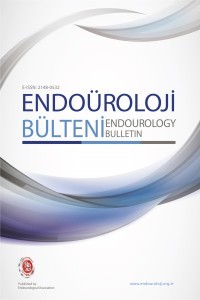Açık parsiyel nefrektomide hemostatik ajan olarak kullanılan oksitlenmiş selüloz desteğin (Surgicel®) postoperatif bilgisayarlı tomografi görünümleri
Hemostatik ajan, Oksitlenmiş selüloz destek (Surgicel®), Parsiyel nefrektomi
Postoperative computed tomography appearances of oxidized cellulose bolster (Surgicel®) used as hemostatic agent in open partial nephrectomy
___
- Kisa E, Sahin H, Cakmak O, et al. Magnetic resonance imaging characteristics and changes in hemostatic agents after partial nephrectomy. Int Urol Nephrol 2019;51:917-925. https://doi.org/10.1007/s11255-019-02141-1
- Carrion DM, Y Gregorio SA, Rivas JG, et al. The role of hemostatic agents in preventing complications in laparoscopic partial nephrectomy. Cent European J Urol 2017;70:362-367. https://doi.org/10.5173/ceju.2017.1432
- Gieraerts C, Vanhoutte E, Laenen A, et al. Safety and efficacy of embolotherapy for severe hemorrhage after partial nephrectomy. Acta Radiol 2020. https://doi.org/10.1177/0284185120907253
- Lang H, Mouracade P, Gimel P, et al. National prospective study on the use of local haemostatic agents during partial nephrectomy. BJU Int 2014;113:E56-61. https://doi.org/10.1111/bju.12397
- Dabestani S, Marconi L, Kuusk T, Bex A. Follow-up after curative treatment of localised renal cell carcinoma. World J Urol 2018;36:1953-1959. https://doi.org/10.1007/s00345-018-2338-z
- Lee MS, Oh YT, Han WK, et al. CT findings after nephron-sparing surgery of renal tumors. AJR Am J Roentgenol 2007;189:W264-W271. https://doi.org/10.2214/AJR.07.2542
- Thorstenson A, Bergman M, Scherman-Plogell AH, et al. Tumour characteristics and surgical treatment of renal cell carcinoma in Sweden 2005-2010: a population-based study from the national Swedish kidney cancer register. Scand J Urol 2014;48:231-238. https://doi.org/10.3109/21681805.2013.864698
- Moch H, Cubilla AL, Humphrey PA, Reuter VE, Ulbright TM. The 2016 WHO classification of tumours of the urinary system and male genital organs-part a: renal, penile, and testicular tumours. Eur Urol 2016;70:93-105. https://doi.org/10.1016/j.eururo.2016.02.029
- Capitanio U, Cloutier V, Zini L, et al. A critical assessment of the prognostic value of clear cell, papillary and chromophobe histological subtypes in renal cell carcinoma: a population-based study. BJU Int 2009;103:1496-1500. https://doi.org/10.1111/j.1464-410X.2008.08259.x
- Janssen MWW, Linxweiler J, Terwey S, et al. Survival outcomes in patients with large (≥7cm) clear cell renal cell carcinomas treated with nephron-sparing surgery versus radical nephrectomy: results of a multicenter cohort with long-term follow-up. PLoS One 2018;13:e0196427. https://doi.org/10.1371/journal.pone.0196427
- Kim TS, Park JG, Kang H, et al. Computed tomography imaging features and changes in hemostatic agents after laparoscopic partial nephrectomy. J Endourol 2016;30:950-957. https://doi.org/10.1089/end.2016.0263
- Pai D, Willatt JM, Korobkin M, et al. CT appearances following laparoscopic partial nephrectomy for renal cell carcinoma using a rolled cellulose bolster. Cancer Imaging 2010;10:161-168. https://doi.org/10.1102/1470-7330.2010.0023
- Maurice MJ, Ramirez D, Kara Ö, et al. Omission of hemostatic agents during robotic partial nephrectomy does not ıncrease postoperative bleeding risk. J Endourol 2016;30:877-883. https://doi.org/10.1089/end.2016.0192
- Yayın Aralığı: 3
- Başlangıç: 2020
- Yayıncı: Pera Yayıncılık
Genç populasyonda mesane tümörlerinin klinik ve patolojik özellikleri
Sercan YILMAZ, Ali YILDIZ, Serdar YALÇIN, Can SİCİMLİ, Ali Fuat ÇİÇEK, Bahadır TOPUZ, Selahattin BEDİR
Arif AYDIN, Gökhan ECER, Muzaffer KILINÇ, Mehmet BALASAR, Nurullah ALTINKAYA, Hakan TAŞKAPU, Mehmet Giray SÖNMEZ
Emre KARABAY, Nejdet KARŞIYAKALI, Kemal KAYAR, Levent VERİM, Çağatay TOSUN, Ömer YÜCEBAŞ
Endoskopik Taş Tedavisinde Gelecekte Bizleri Ne Bekliyor?
Fatih SANDIKÇI, Burhan BAYLAN, Abdurrahim İMAMOĞLU
Laparoskopik nefrektomide spesmen çıkarma yönteminin hasta memnuniyetine etkisi
Serkan DOĞAN, Bülent ÇELİK, Mehmet YILMAZ
Thulium Lazer ile Prostat Enükleasyonu(ThuLEP) deneyimleri
Eymen GAZEL, Mehmet YILMAZ, Halil Çağrı AYBAL, Engin KAYA, Serdar YALÇIN, Sercan YILMAZ, Onur AÇIKGÖZ, Lütfi TUNÇ
Retzius Koruyucu Robot Yardımlı Laparoskopik Radikal Prostatektomi
Serkan ALTINOVA, Çağrı GÜNERİ, Muhammet Fuat ÖZCAN
Laparoskopik üreterolitotomi; siz hangi yolu tercih ediyorsunuz?
Bahadır TOPUZ, Sercan YILMAZ, Serdar YALÇIN, Sanan ASGARLI, Engin KAYA, Murat ZOR, Mesut GÜRDAL, Selahattin BEDİR
